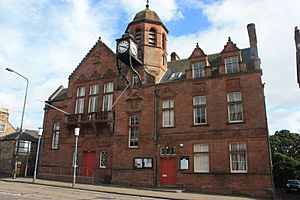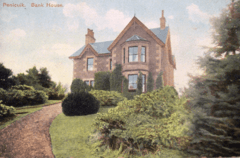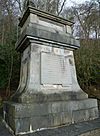Penicuik facts for kids
Quick facts for kids Penicuik
|
|
|---|---|
 Penicuik Town Hall |
|
| Population | 16,150 (2020) |
| OS grid reference | NT2359 |
| • Edinburgh | 8.5 mi (13.7 km) |
| • London | 324 mi (521 km) |
| Council area | |
| Lieutenancy area | |
| Country | Scotland |
| Sovereign state | United Kingdom |
| Post town | PENICUIK |
| Postcode district | EH26 |
| Dialling code | 01968 |
| Police | Lothian and Borders |
| Fire | Lothian and Borders |
| Ambulance | Scottish |
| EU Parliament | Scotland |
| UK Parliament |
|
| Scottish Parliament |
|
Penicuik ( pen-I-kuuk; Scots: Penicuik; Scottish Gaelic: Peighinn na Cuthaig) is a town and former burgh in Midlothian, Scotland, lying on the west bank of the River North Esk. It lies on the A701 midway between Edinburgh and Peebles, east of the Pentland Hills.
Summary
Its population at the 2011 census was 15,926 computed according to the 2010 definition of the locality. The town was developed as a planned village in 1770 by Sir James Clerk of Penicuik. It became a burgh in 1867. The town was well known for its paper mills, the last of which closed in 2004. More recently the town was home to the Edinburgh Crystal works. Penicuik has two secondary schools, Penicuik High School and Beeslack Community High School.
Crystal FM is the Community Radio Station serving Penicuik & S W Midlothian on 107.4
The town's name is pronounced 'Pennycook' and is derived from Pen Y Cog, meaning "Hill of the Cuckoo" in the Old Brythonic language (also known as Ancient British and the forerunner of modern Welsh). Penicuik is Scotland's 50th largest town and the biggest settlement in Midlothian.
Near Penicuik is Glencorse Parish Kirk, which formed part of the inspiration for Robert Louis Stevenson's Kidnapped (1886). Some of the streets nearby are named after characters in the novel and its sequel, Catriona (1893). Penicuik is home to the Royal Highland Fusiliers, 2nd Battalion The Royal Regiment of Scotland, garrisoned in Glencorse Barracks.
Penicuik is twinned with the town of L'Isle-sur-la-Sorgue in France.
History
In 1296 Thomas Rymer's Foedera mentions a "Walter Edgar a person of Penicok south of Edenburgh", which logically can only be what is now called Penicuik.
Penycook appears as the name on John Adair's map of 1682.
The ruined old parish church, in the centre of the graveyard, dates from the late 17th century.
The site of Penicuik was home to the paper mill established by Agnes Campbell in 1709. A monument in the churchyard reads "1737, Annabel Millar spouse to Thomas Rutherford Papermaker at Pennycuik".
Around 1770, the arrival of the Cowan family, and their expansion of the paper mill, led to the need for homes for their workers. The hamlet of Penicuik was expanded as a planned town (roughly based on Edinburgh's New Town) by Sir James Clerk of Penicuik, the builder of nearby Penicuik House, and by 1800 the population had risen to 1,700.
Penicuik was the site of a prison camp for French prisoners during the Napoleonic Wars (housed in the old range at Valleyfield Mill). The former camp is now the site of a housing development in Valleyfield. A monument dated 1830 by the River Esk commemorates "the mortal remains of 309 prisoners of war who died 1811-14". It was erected by Alexander Cowan owner of the paper mill, whose house overlooked the burial site.
Penicuik hosted the inaugural Grand Match in curling, between the north and the south of Scotland, in 1847. This took place on the "high pond" on the estate of Penicuik House, not the "low pond" which is still used for curling on rare occasions. The town became a burgh in 1867. In the oldest part of Penicuik, surrounding the town centre and to the south of the former POW camp, crossing the river Esk is Pomathorn Bridge which was once a toll bridge and the main route between Edinburgh to the north and the Scottish Borders to the south. As such Penicuik has a number of ancient traveller's inns, including The Crown, and the Royal. Because of their location on such a busy caravan route, both these public houses advertise the patronage of many characters from Scottish 18th Century history, including alleged visits from Burke and Hare and Bonnie Prince Charlie.
The town, whilst generally architecturally undistinguished contains two masterpieces by Frederick Thomas Pilkington: the South Church (originally the United Free Church, of 1862; and the flamboyant "Park End" houses on Bridge Street also of 1862.
Paper mills
Paper-making is thought to have started here in 1709. The best firm evidence of early paper-making lies in the parish churchyard, where the grave of Thomas Rutherford, dated 1735, describes him as "papermaker". There were at least two established paper-mills in the town. In the mid 18th century Charles Cowan, originally a grocer in Leith, established the Cowan Valleyfield Mills. In 1796, Cowan brought in his son, Alexander Cowan, to manage the mill. An adjacent corn mill was purchased in 1803, becoming known as Bank Mill after he converted it to produce the paper on which banknotes were printed. The Valleyfield Mills were used as a prisoner of war camp (mainly for French prisoners) from March 1811 until September 1814, often referred to as the Napoleonic War but more correctly at this period being the Peninsula War. Cowan erected a monument to their memory after the war to the north side of the mills. Apart from a small mill chapel and school, today this is all that survives and the mills themselves have gone. Only the road names (Waterloo Bank, Cowan Bank etc.) now echo this part of the town's history.
Paper was also produced at Eskmill which has become a site for private housing. The Dalmore paper mill on the North Esk river at Auchendinny closed in 2004.
Climate
Penicuik experiences a maritime climate with cool summers and mild winters. The town's somewhat elevated position means it is more susceptible to snowfall than nearby Edinburgh; over 30 days of the year on average reported lying snow between 1951 and 1980, compared to 14 at Edinburgh. Temperature extremes since 1960 range from 30.2 °C (86.4 °F) during July 1983 to −19.2 °C (−2.6 °F) in January 1982. The coldest temperature in recent years was −12.5 °C (9.5 °F) during January 2010.
| Climate data for Penicuik, 185m asl 1981-2010, extremes 1960- | |||||||||||||
|---|---|---|---|---|---|---|---|---|---|---|---|---|---|
| Month | Jan | Feb | Mar | Apr | May | Jun | Jul | Aug | Sep | Oct | Nov | Dec | Year |
| Record high °C (°F) | 12.4 (54.3) |
13.3 (55.9) |
19.4 (66.9) |
25.6 (78.1) |
27.2 (81.0) |
28.9 (84.0) |
30.2 (86.4) |
29.4 (84.9) |
26.2 (79.2) |
20.6 (69.1) |
15.6 (60.1) |
13.1 (55.6) |
30.2 (86.4) |
| Average high °C (°F) | 5.5 (41.9) |
6.1 (43.0) |
8.5 (47.3) |
11.4 (52.5) |
14.6 (58.3) |
16.9 (62.4) |
18.9 (66.0) |
18.3 (64.9) |
15.5 (59.9) |
11.6 (52.9) |
8.0 (46.4) |
5.6 (42.1) |
11.8 (53.2) |
| Average low °C (°F) | −0.2 (31.6) |
0.1 (32.2) |
1.2 (34.2) |
2.6 (36.7) |
4.9 (40.8) |
7.9 (46.2) |
9.7 (49.5) |
9.5 (49.1) |
7.5 (45.5) |
4.6 (40.3) |
2.0 (35.6) |
−0.4 (31.3) |
4.2 (39.6) |
| Record low °C (°F) | −19.2 (−2.6) |
−13.9 (7.0) |
−14.6 (5.7) |
−6.9 (19.6) |
−4.5 (23.9) |
−1.7 (28.9) |
1.1 (34.0) |
0.4 (32.7) |
−2.3 (27.9) |
−6.2 (20.8) |
−10 (14) |
−14.8 (5.4) |
−19.2 (−2.6) |
| Average precipitation mm (inches) | 100.60 (3.96) |
74.67 (2.94) |
73.00 (2.87) |
59.25 (2.33) |
62.34 (2.45) |
76.41 (3.01) |
80.44 (3.17) |
81.82 (3.22) |
83.03 (3.27) |
105.83 (4.17) |
92.06 (3.62) |
90.41 (3.56) |
982.32 (38.67) |
| Source: Royal Dutch Meteorological Institute/KNMI | |||||||||||||
Twin town
 L'Isle-sur-la-Sorgue in the region of Provence.
L'Isle-sur-la-Sorgue in the region of Provence. Midlothian, Chicago (along with all other towns in Midlothian, Scotland).
Midlothian, Chicago (along with all other towns in Midlothian, Scotland).
Notable people

Notable people connected with Penicuik include;
- Jim Aitken, Scotland rugby union captain
- Joseph Bell FRCSE, surgeon and lecturer at the medical school of the University of Edinburgh
- Sir John Clerk, baronet, composer and leading Scottish politician during the period leading up to the 1707 Act of Union
- Alexander Cowan, papermaker and philanthropist
- Charles Cowan, papermaker and MP for Edinburgh
- James Cowan, Liberal Party politician
- Sir John Cowan
- Samuel Rutherford Crockett
- James Finlayson
- Cargill Gilston Knott, FRS, mathematician and seismologist
- James Cossar Ewart, FRS, zoologist, whose home, Craigiebield House, is now a hotel
- Sir James Hamilton, Aircraft designer who led the British Concorde development team James Arnot Hamilton
- Helen Bannerman, writer
- Charles Thomson Rees Wilson, Nobel prize-winning physicist, was born at a nearby farm
- Tommy Banner, musician (The Wurzels)
- Chris Kane, footballer
- Sam Nicholson, footballer
- Sir Geoff Palmer, scientist and human rights activist
- Claire Emslie, footballer
- Craig Paterson, footballer
Images for kids
See also
 In Spanish: Penicuik para niños
In Spanish: Penicuik para niños









